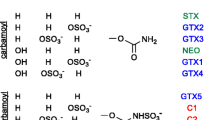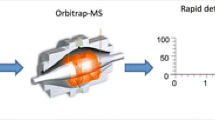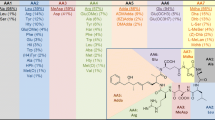Abstract
Accurate analyses of T-2 and HT-2 toxin in aquatic organisms including shrimp are important as these two toxins are increasingly detected in aquatic cereal-based feed. Therefore, the potential for these toxins to enter the human food chain from contaminated fish and shrimp products is very real. A rapid, sensitive, and validated method for simultaneous determination of T-2 and HT-2 toxins was developed using a liquid chromatography-tandem mass spectrometry (LC-MS/MS) method following extraction of the two toxins from shrimp tissues with ethyl acetate. This method is simple in that additional solid-phase extraction is not required to isolate and purify the toxins. LC was performed on an analytical Hypersil GOLD column. The mobile phase consisted of methanol and 5 mM ammonium acetate containing 0.1 % formic acid. The MS/MS ion transitions for both the T-2 toxin (484.20 → 214.87) and HT-2 toxin (442.20 → 214.96) were monitored. And the most intense transition ion product (m/z) of T-2 and HT-2 used for quantification on the SRM mode of a mass spectrometer was 304.95 and 262.91, respectively. The results linearly correlated with coefficients >0.9990. The limits of quantification ranged from 0.02 to 0.51 ng·g−1 and from 0.17 to 4.48 ng·g−1 for T-2 and HT-2, respectively, depending on the shrimp tissue type. The overall extraction recovery for both toxins ranged between 84 and 111 % with RSD values less than 15.0 %, indicative of good replication. Furthermore, the recovery and precision levels were within the predefined limits (≤15 %) at all concentrations. The application of this method to study the accumulation of T-2 toxin in shrimp showed that it can be successfully used to monitor even very low tissue toxin concentrations. Research is in progress to extend this method for the measurement of T-2 and HT-2 in aquatic foods that enter the human food chain.












Similar content being viewed by others
References
Allander E (1994) Kashin-Beck-disease - an analysis of research and public health activities based on a bibliography 1849–1992. Scand J Rheumatol 23:1–36
Bao Y, Liu Q, Chen J, Lin Y, Wu B, Xie J (2012) Quantification of nerve agent adducts with albumin in rat plasma using liquid chromatography-isotope dilution tandem mass spectrometry. J Chromatogr A 1229:164–171 (in Chinese)
Barna-Vetro I, Gyongyosi A, Solti L (1994) Monoclonal antibody-based enzyme-linked immunosorbent assay of Fusarium T-2 and zearalenone toxins in cereals. Appl Environ Microbiol 60:729–731
Biselli S, Hummert C (2005) Development of a multicomponent method for Fusarium toxins using LC-MS/MS and its application during a survey for the content of T-2 toxin and deoxynivalenol in various feed and food samples. Food Addit Contam 22:752–760
Bottalico A (1998) Fusarium diseases of cereals: species complex and related mycotoxin profiles, in Europe. J Plant Pathol 80:85–103
Bu L, Chen S, Liu N et al (2001) The observation of DNA damage caused by HT-2 toxin with SCGE. Chin J Endemiol 20:14–15 (in Chinese)
Chen X (2011) General situation of mycotoxin contamination in mixed feed and raw materials in China from 2009 to 2010. Zhejiang Anim Husb Vet Med 2:7–10 (in Chinese)
Cristina J, Alberto R, Jordi M (2012) Determination of trichothecenes and zearalenones in grain cereal, flour and bread by liquid chromatography tandem mass spectrometry. Food Chem 134:2389–2397
De Baere S, Goossens J, Osselaere A, Devreese M, Vandenbroucke V, De Backer P, Croubels S (2011) Quantitative determination of T-2 toxin, HT-2 toxin, deoxynivalenol and deepoxy-deoxynivalenol in animal body fluids using LC-MS/MS detection. J Chromatogr B 879:2403–2415
Doi AM, Holmes E, Kleinow KM (2001) P-glycoprotein in the catfish intestine: inducibility by xenobiotics and functional properties. Aquat Toxicol 55:157–170
European Commission (2006) European Commission Regulation (EC) No. 401/2006 of 23 February 2006 laying down the methods of sampling and analysis for the official control of the levels of mycotoxins in foodstuffs. OJEU L70:12–34
Haubl G, Berthiller F, Hametner C, Rechthaler J, Jaunecker G, Freudenschuss M, Krska R, Schuhmacher R (2007) Characterization of (13C24) T-2 toxin and its use as an internal standard for the quantification of T-2 toxin in cereals with HPLC–MS/MS. Anal Bioanal Chem 389:931–940
ICH-Guidelines Q2B (1996) Note for guidance on validation of analytical procedures, methodology. International Conference on Harmonization, Human Medicines Evaluation Unit, the European Agency for the Evaluation of Medicinal Products
Jiménez M, Mateo JJ, Mateo R (2000) Determination of type A trichothecenes by high-performance liquid chromatography with coumarin-3-carbonyl chloride derivatisation and fluorescence detection. J Chromatogr A 870:473–481
Johnsen H, Odden E, Johnsen BA, Fonnum F (1988) Metabolism of T-2 toxin by blood cell carboxylesterases. Biochem Pharmacol 37:3193–3197
Krska R, Baumgartner S, Josephs R (2001) The state-of-the-art in the analysis of type-A and -B trichothecene mycotoxins in cereals. Fresenius J Anal Chem 371:285–299
Kuhn DD, Smith SA, Boardman GD, Angier MW, Marsh L, Flick GJ (2010) Chronic toxicity of nitrate to Pacific white shrimp, Litopenaeus vannamei: impacts on survival, growth, antennae length, and pathology. Aquaculture 309:109–114
Lattanzio VMT, Pascale M, Visconti A (2009) Current analytical methods for trichothecene mycotoxins in cereals. TrAC-Trends Anal Chem 28:758–768
Leal M, Shimada A, Ruíz F, González de Mejía E (1999) Effect of lycopene on lipid peroxidation and glutathione-dependent enzymes induced by T-2 toxin in vivo. Toxicol Lett 109:1–10
Liu N, Ren Z (1998) Study on DNA damage caused by HT-2 toxin. Chinese J Endemiology 17:72–74
Lorke D (1983) A new approach to practical acute toxicity testing. Arch Toxicol 54:275–287
Manning BB, Li MH, Robinson EH, Gaunt PS, Alvin C (2003) Response of Channel catfish to diets containing T-2 toxin. J Aquat Anim Health 15:229–238
Mateo JJ, Mateo R, Jiménez M (2002) Accumulation of type A trichothecenes in maize, wheat and rice by Fusarium sporotrichioides isolates under diverse culture conditions. Int J Food Microbiol 72:115–123
Meneely JP, Ricci F, Van Egmond HP, Elliott CT (2011) Current methods of analysis for the determination of trichothecene mycotoxins in food. TrAC-Trend Anal Chem 30:192–203
Minervini F, Fornelli F, Lucivero G, Romano C, Visconti A (2005) T-2 toxin immunotoxicity on human B and T lymphoid cell lines. Toxicology 210:81–91
Mou R, Cao Z, Jin L, Zhu Z, Chen M (2009) Determination of T-2 and HT-2 toxin cereals by HPLC-MS with immunoaffinity column. J Instrum Anal 28:368–371 (in chinese)
Petterson H, Langseth W (2002) Intercomparison of trichothecene analysis and feasibility to produce certified calibrants and reference material, BCR Information, Project reports EUR 20285/1 EN (part I) and EUR 20285/2 EN (part II). European Commission, Brussels
Poston NA, Coffin DL, Combs GF Jr (1983) Biological effects of dietary T-2 toxin on rainbow trout, Salmo gardneri. Aquat Toxicol 1:79–88
Schothorst RC, van Egmond HP (2004) Report from SCOOP task 3.2.10 “collection of occurrence data of Fusarium toxins in food and assessment of dietary intake by the population of EU member states”. Subtask: trichothecenes. Toxicol Lett 153:133–143
Senyuva HZ, Gilbert J, Turkoz G, Leeman D, Donnelly C (2012) Analysis of deoxynivalenol, zearalenone, T-2, and HT-2 toxins in animal feed by LC/MS/MS-A critical comparison of immunoaffinity column cleanup with no cleanup. J AOAC Int 95:1701–1708
Sibanda L, De Saeger S, Van Peteghem C, Grabarkiewicz-Szczesna J, Tomczak M (2000) Detection of T-2 toxin in different cereals by flow-through enzyme immunoassay with a simultaneous internal reference. J Agric Food Chem 48:5864–5867
Statistical Information Center of Heath Ministry of China (2005) Report on population survey of prevention and treatment of Kashin-Beck disease of China in 2005. Chin J Endemiol 24:589–591 (in Chinese)
Supamattaya K, Bundit O, Boonyarapatlin M, Schatzmayr G (2006) Effects of mycotoxins T-2 and zearalenone on growth performance immune-physiological parameters and histological changes in black tiger shrimp (Penaeus monodon) and white shrimp (Litopenaeus vannamei). XII International Symposium of Fish Nutrition and Feeding. May 28 - June 1. Biarritz, France
Thompson WL, Wannemacher RW Jr (1990) In vivo effects of T-2 mycotoxin on synthesis of proteins and DNA in rat tissues. Toxicol Appl Pharmacol 105:483–491
Ueno Y, Umemori K, Niimi E, Tanuma S, Nagata S et al (1995) Induction of apoptosis by T-2 toxin and other natural toxins in HL-60 human promyelotic leukemia cells. Nat Toxins 3:129–137
Wang R, Miao C, Zhang Z et al (2003) Recent trends of mycotoxin contamination in animal feeds and raw materials in China. Feed Indus 24:53–54 (in Chinese)
Wang S, Guo X, Zuo H, Zhang Y, Xu P, Ping Z, Zhang Z, Geng D (2006) Chondrocyte apoptosis and expression of Bcl-2, Bax, Fas, and NOS in articular cartilage in patients with Kashin-Beck disease. J Rheumatol 33:615–619
WHO (World Health Organization) (2002) Evaluation of certain mycotoxins in food. Fifty-sixth report of the Joint FAO/WHO Expert Committee on Food Additives, vol 906. WHO Technical Report, Geneva, pp 1–62
Yang JB (1995) Research report on the etiology of Kashin-Beck disease. Chin J Endemiol 14:701–703 (in Chinese)
Zhang ZQ (2009) The contamination and distribution rule of aflatoxin B1, T-2 toxin and ochratoxin A in feedstuffs in China. SCAU, Sichuan (in Chinese)
Zou Z, He Z, Li H, Han P, Tang J, Xi C, Li Y, Zhang L, Li X (2012) Development and application of a method for the analysis of two trichothecenes: deoxynivalenol and T-2 toxin in meat in China by HPLC-MS/MS. Meat Sci 90:613–617 (in Chinese)
Author information
Authors and Affiliations
Corresponding authors
Ethics declarations
Funding
This study was financially supported by the National Natural Science Foundation of China (NSFC) (No. 31171634 and No. 31371777 and No. 31371746 and No. 31201309) and higher educational cultivation program for major scientific research projects of Guangdong Ocean University (No. GDOU2013050205).
Conflict of Interest
All authors declare that they have no conflict of interest.
Ethical approval
This study was approved by the Animal Welfare Committee of Guangdong Ocean University (Approval # SYXK 2014-0053). All applicable institutional guidelines for the care and use of animals were followed. This article did not contain any studies with human participants performed by any of the authors.
Informed Consent
Not applicable.
Rights and permissions
About this article
Cite this article
Lu, P., Wu, C., Shi, Q. et al. A Sensitive and Validated Method for Determination of T-2 and HT-2 Toxin Residues in Shrimp Tissues by LC-MS/MS. Food Anal. Methods 9, 1580–1594 (2016). https://doi.org/10.1007/s12161-015-0336-y
Received:
Accepted:
Published:
Issue Date:
DOI: https://doi.org/10.1007/s12161-015-0336-y




